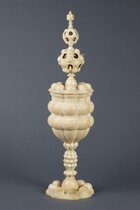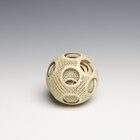Just saw this on r/turning. Generally I wouldn't cross post, but this is an amazing of skilled work that would put any of us to shame. Adam Savage visited the Metropolitan Museum and saw this set of 74 nested cups, each paper thin. Remember what kind of turning equipment was available at that time.
View: https://www.youtube.com/watch?v=xhzZkD6gytg
-
January 2026 Turning Challenge: Turned and Bent! (click here for details) -
Congratulations to Phil Hamel, People's Choice in the December 2025 Turning Challenge (click here for details) -
Congratulations to David Wyke for "Maple Platter #567" being selected as Turning of the Week for January 5, 2026 (click here for details) -
Welcome new registering member. Your username must be your real First and Last name (for example: John Doe). "Screen names" and "handles" are not allowed and your registration will be deleted if you don't use your real name. Also, do not use all caps nor all lower case.
You are using an out of date browser. It may not display this or other websites correctly.
You should upgrade or use an alternative browser.
You should upgrade or use an alternative browser.
Nested cup turning from ~1650
- Thread starter Karl Best
- Start date
Very interesting movie. Can't imagine how they did it!
Someone spent a lot of time on that. Probably cussing and starting a new little cup many times.
We should all keep this in mind the next time we imagine we are clever.
It would be educational to see the the lathe and tools they used.
It would be educational to see the the lathe and tools they used.
Cool video and object. Thanks for sharing, Karl. I found the discussion on work-holding for restoration and display interesting. It speaks to the similar challenges that most of face when making our pieces. Problem-solving is one of the stimulating (and satisfying) aspects of turning, and woodwork in general.
Indeed! It demonstrates that what we consider the relatively 'primitive' technologies of past centuries were capable of remarkable feats when used by skilled craftsmen. Much of the specialized and elaborate [woodturning] equipment and tools we consider indispensable can be replaced by skills combined with 'simple' technologyWe should all keep this in mind the next time we imagine we are clever. It would be educational to see the the lathe and tools they used.
I agree!... Problem-solving is one of the stimulating (and satisfying) aspects of turning, and woodwork in general.
For those who haven't seen it, Doc Green wrote a useful book on work-holding for the lathe:
I've had the original version for years. I've pre-ordered the updated version to compare. I'll try to get back about that.
JKJ
I saw that yesterday too. My first thought was that it was very cool. My second thought was - I wonder if it was turned by an ancestor of Mike Mahoney! 

Who would do this??? 73 individual cups of the same shape, super thin walled??? The maker would have spent months and months on this one item. Could he have sold it for enough to make it worthwhile? What sort of obsessive personality would you have to have to do it?
Who would do this??? 73 individual cups of the same shape, super thin walled??? The maker would have spent months and months on this one item. Could he have sold it for enough to make it worthwhile? What sort of obsessive personality would you have to have to do it?
If I heard right, it may have been made for the local royalty. And I wondered about the effort, but who knows, maybe 50 people were tasked with working on it simultaneously!
Oh, to be a time traveler and go back and learn things...
JKJ
The maker wouldn't have done it if took months and months -- he would have starved. Don't underestimate the effects of skills when combined with simpler technologies. Perhaps an obsessive personality, but clearly great skills.Who would do this??? 73 individual cups of the same shape, super thin walled??? The maker would have spent months and months on this one item. Could he have sold it for enough to make it worthwhile? What sort of obsessive personality would you have to have to do it?
- Joined
- Apr 27, 2004
- Messages
- 9,309
- Likes
- 6,082
- Location
- Lakeland, Florida
- Website
- www.hockenberywoodturning.com
Who would do this??? 73 individual cups of the same shape, super thin walled??? The maker would have spent months and months on this one item. Could he have sold it for enough to make it worthwhile? What sort of obsessive personality would you have to have to do it?
Probably made to give the owner bragging rights.
During the renaissance and enlightenment times most artisans worked for kings, queens, and nobles of high rank.
These well to do folks used unusual turnings as show off items and as special gifts.
Museums have many examples of these turnings often in ivory. David Springette got a lot of inspiration from museum pieces for his work. Here are a two ivory turnings, a cup and nested spheres, from the a Victoria and Albert museum


We got an insight to the capriciousness of those rulers of those times from a fable about Kilimanjaro moving from Kenya to Tanzania. According to legend, queen Victoria gave Kilimanjaro to Kaiser Wilhelmina as birthday present after he complained that she had 2 mountains and he had none. She kept Mt Kenya.
The more accurate story was an uninteresting land swap to add coastline to Kenya.
